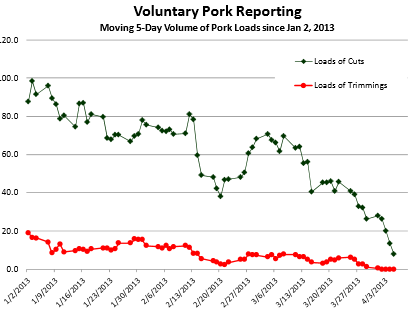



CME: National Carlot Pork Report to be Discontinued
US - USDA announced on Friday that as of Friday, 12 April, the USDA National Carlot Pork Report would be discontinued, write Steve Meyer and Len Steiner.In its place, USDA now will track two reports that rely on actual data that packers report to USDA twice a day. The two so-called mandatory pork reports will report pricing both as FOB Plant and FOB Omaha. As we have noted in several previous issues, the change to the mandatory pork price reporting should provide better visibility of pricing in the wholesale pork market.
Market participants have had three months to prepare for the eventual change although the decision by USDA to stop the voluntary report still caught some in the market by surprise. The expectation was that USDA probably would continue to report the voluntary prices until the end of the month. The following chart shows the volume of loads in the voluntary report since 2 January.

It is obvious that once USDA decided to report the mandatory prices concurrently with the voluntary prices on 1 April, the volume of pork reported in the voluntary Carlot Pork Report fell off dramatically. On 10 and 11 April, there were no pork loads reported in the voluntary report, which forced the USDA to pull the plug. While some, including this writer, would have wanted USDA to continue publishing the two reports side by side for at least six months in order to have a more complete data series, that proved to be impractical in reality.
The expectation coming into the implementation of the mandatory pork report was that the prices presented by the voluntary report would be higher than prices in the mandatory reports. Given that the pork market in recent years had become increasingly opaque, some speculated th at packers had an incentive to report only the highest prices in the voluntary Carlot Report.
The reality of the pork price reporting in the last three months has shown that the opposite was true. The pork cutout as reported by the mandatory price report has been consistently above the pork cutout calculated using voluntary prices. The average spread in the cutout values was 3.95 cents or 5 per cent, quite a significant difference.

Indeed, given this wide difference between the two reports, most packers had an incentive to discontinue to report voluntary prices and did so as soon as was possible, again making the production of a voluntary report by USDA no longer viable. As to the reasons for the big spread between the prices in the voluntary report and in the mandatory report we have a pretty good opinion why.
However, our stand is to limit as much as possible giving our opinion on trade matters, especially since both packers and end users are currently involved in renegotiating their formulations to account for the changes in pricing references. Those that we work with, already know our position on this matter. Suffice to say that more work will be done in the coming weeks to bring pricing at various levels of the supply chain into alignment with the changes in the USDA pricing sheets.
We have included pricing on a number of items, hams, loins, bellies, based on the new mandatory price reporting system. As a result, for now, we are not comparing those numbers to a year ago given the discrepancy in prices. We are still working on a way to correct for this issue but until we figure this out, there will be an N/A in the summary table. See full details on prices and production below.









